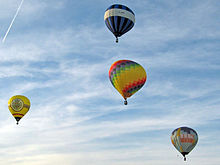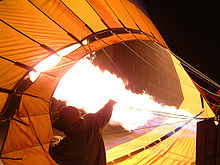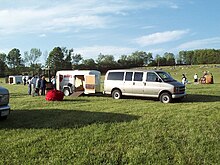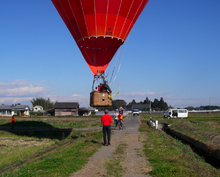
An aircraft is a vehicle that is able to fly by gaining support from the air. It counters the force of gravity by using either static lift or the dynamic lift of an airfoil, or, in a few cases, direct downward thrust from its engines. Common examples of aircraft include airplanes, helicopters, airships, gliders, paramotors, and hot air balloons.

A hot air balloon is a lighter-than-air aircraft consisting of a bag, called an envelope, which contains heated air. Suspended beneath is a gondola or wicker basket, which carries passengers and a source of heat, in most cases an open flame caused by burning liquid propane. The heated air inside the envelope makes it buoyant, since it has a lower density than the colder air outside the envelope. As with all aircraft, hot air balloons cannot fly beyond the atmosphere. The envelope does not have to be sealed at the bottom, since the air inside the envelope is at about the same pressure as the surrounding air. In modern sport balloons the envelope is generally made from nylon fabric, and the inlet of the balloon is made from a fire-resistant material such as Nomex. Modern balloons have been made in many shapes, such as rocket ships and the shapes of various commercial products, though the traditional shape is used for most non-commercial and many commercial applications.

Unpowered aircraft can remain airborne for a significant period of time without onboard propulsion. They can be classified as gliders, lighter-than-air balloons and tethered kites. In the case of kites, lift is obtained by tethering to a fixed or moving object, perhaps another kite, to obtain a flow of wind over the lifting surfaces. In the case of balloons, lift is obtained through inherent buoyancy and the balloon may or may not be tethered. Free balloon flight has little directional control. Gliding aircraft include sailplanes, hang gliders, and paragliders that have full directional control in free flight.
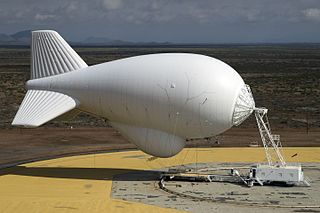
An aerostat is a lighter-than-air aircraft that gains its lift through the use of a buoyant gas. Aerostats include unpowered balloons and powered airships. A balloon may be free-flying or tethered. The average density of the craft is lower than the density of atmospheric air, because its main component is one or more gasbags, a lightweight skin containing a lifting gas to provide buoyancy, to which other components such as a gondola containing equipment or people are attached. Especially with airships, the gasbags are often protected by an outer envelope.

In aeronautics, a balloon is an unpowered aerostat, which remains aloft or floats due to its buoyancy. A balloon may be free, moving with the wind, or tethered to a fixed point. It is distinct from an airship, which is a powered aerostat that can propel itself through the air in a controlled manner.

The Albuquerque International Balloon Fiesta is a yearly hot air balloon festival that takes place in Albuquerque, New Mexico, during early October. The Balloon Fiesta is a nine-day event occurring in the first full week of October, and has over 500 hot air balloons each year far from its beginnings of merely 13 balloons in 1972. The event is the largest balloon festival in the world, followed by the Grand Est Mondial Air in France, and the León International Balloon Festival in Mexico.
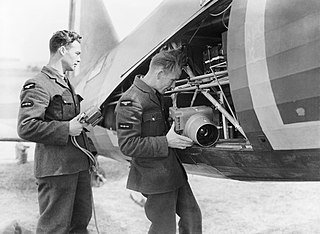
In all forms of aviation, ground crew are personnel that service aircraft while on the ground, during routine turn-around; as opposed to aircrew, who operate all aspects of an aircraft whilst in flight. The term ground crew is used by both civilian commercial airlines and in military aviation.

Jean-François Pilâtre de Rozier was a French chemistry and physics teacher, and one of the first pioneers of aviation. He made the first manned free balloon flight with François Laurent d'Arlandes on 21 November 1783, in a Montgolfier balloon. He later died when his balloon crashed near Wimereux in the Pas-de-Calais during an attempt to fly across the English Channel. He and his companion Pierre Romain thus became the first known fatalities in an air crash.

A gas balloon is a balloon that rises and floats in the air because it is filled with a gas lighter than air. When not in flight, it is tethered to prevent it from flying away and is sealed at the bottom to prevent the escape of gas. A gas balloon may also be called a Charlière for its inventor, the Frenchman Jacques Charles. Today, familiar gas balloons include large blimps and small latex party balloons. For nearly 200 years, well into the 20th century, manned balloon flight utilized gas balloons before hot-air balloons became dominant. Without power, heat or fuel, untethered flights of gas balloons depended on the skill of the pilot. Gas balloons have greater lift for a given volume, so they do not need to be so large, and they can stay up for much longer than hot air balloons.

A hopper balloon is a small, one-person hot air balloon. Unlike a conventional hot air balloon where people ride inside a basket, there is no basket on a hopper balloon. Instead, the hopper pilot usually sits on a seat or wears a harness similar to a parachute harness. Hoppers are typically flown for recreation. These aircraft are sometimes called "cloud hoppers" or "cloudhoppers". However, these terms formally refer to the products of a particular manufacturer, specifically Lindstrand Balloons. Nonetheless, "cloudhopper" is used by many people as a genericized trademark, which refers to all craft of this general type. Most hopper balloons have envelopes that range in volume from 14,000 to 35,000 cubic feet and have a maximum flight duration of 1 to 1.5 hours. The two principal commercial balloon manufacturers today offering hopper balloons for sale are Cameron Balloons and Lindstrand Balloons. Most other hopper balloons are experimental aircraft designed and built by amateur constructors.
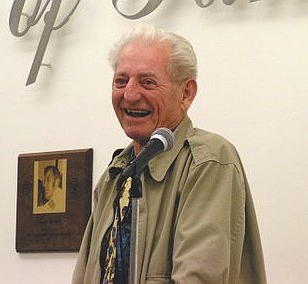
Paul Edward Yost was the American inventor of the modern hot air balloon and is referred to as the "Father of the Modern Day Hot-Air Balloon." He worked for a high-altitude research division of General Mills in the early 1950s until he left to establish Raven Industries in 1956, along with several colleagues from General Mills.

Donald Louis Piccard was a Swiss-born American balloon pioneer, promoter, innovator, designer, builder, and pilot.

Balloons and kites were the first inventions used in aerial warfare and their primary role was observation. Balloons provided an unreliable and stable means of elevating an observer high over the battlefield to obtain a birds-eye view of troop positions and movements. An early instrument of aerial intelligence collection, they were also useful for creating accurate battlefield maps, an important ingredient for battlefield success. Incendiary balloons also have a long history. The incendiary balloons carry hot air or something that can catch fire to destroy enemy territory. They could also hold small bombs for combat. The history of military ballooning dates back to the late 18th century, when the Montgolfier brothers, Joseph-Michel and Jacques-Étienne, first demonstrated the potential of hot-air balloons for military use. The first recorded military use of balloons was during the French Revolutionary Wars, when the French military used balloons to gather intelligence on the movements of the enemy. Balloons were also used during the American Civil War, where they were used for reconnaissance and communication. Balloons had a decline after several incidents in the interwar period.
Per Lindstrand is a Swedish aeronautical engineer, pilot, adventurer and entrepreneur. He is particularly known for his series of record-breaking trans-oceanic hot air balloon flights and, later, attempts to be the first to fly a Rozière balloon around the Earth – all with British entrepreneur, Sir Richard Branson. He is also the founder of eponymous Lindstrand Balloons hot air balloon manufacturer based in Oswestry, England.

The history of ballooning, both with hot air and gas, spans many centuries. It includes many firsts, including the first human flight, first flight across the English Channel, first flight in North America, and first aircraft related disaster.

Dominic Michaelis was an Anglo-French architect, inventor, and solar energy advocate.

On 7 January 2012, a scenic hot air balloon flight from Carterton, New Zealand, collided with a high-voltage power line while attempting to land, causing it to catch fire, disintegrate and crash just north of the town, killing all eleven people on board.
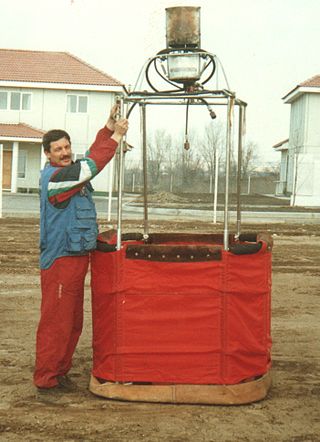
Victor Zagainov was a hot air balloon pilot and astronomer from Kazakhstan. He was the first and only hot air balloon champion of the USSR (1991), Hot Air Balloon champion of the Republic of Kazakhstan (1993), the winner of the International Balloon Grand Prix Todi (Italy) (1993), the champion of the CIS (1996). He organized Grand Prix of Zagainov and was awarded Fédération Aéronautique Internationale (FAI) Diploma for Outstanding Airmanship and the FAI Air Sport Medal in 2003.

Eugène Godard Ainé was a French aeronaut, born in Clichy on August 26, 1827, died in Brussels on September 9, 1890.

Spirit of Freedom balloon was a Rozière balloon designed and built by Donald Cameron and Tim Cole. In 2002 solo pilot Steve Fossett flew the Spirit of Freedom to become the first successful around-the-world nonstop solo flight in any kind of aircraft. On June 19, 2002, the 10-story-high balloon Spirit of Freedom lifted off from Northam, Western Australia, and landed in Queensland, Australia, on July 3, 2002. The solo flight circumnavigation lasted 13 days, 8 hours, 33 minutes and covered 20,626.48 statute miles (33,195.10 km). They reached speeds of up to 322 kilometers per hour, and flew as high as 10,580 meters.


